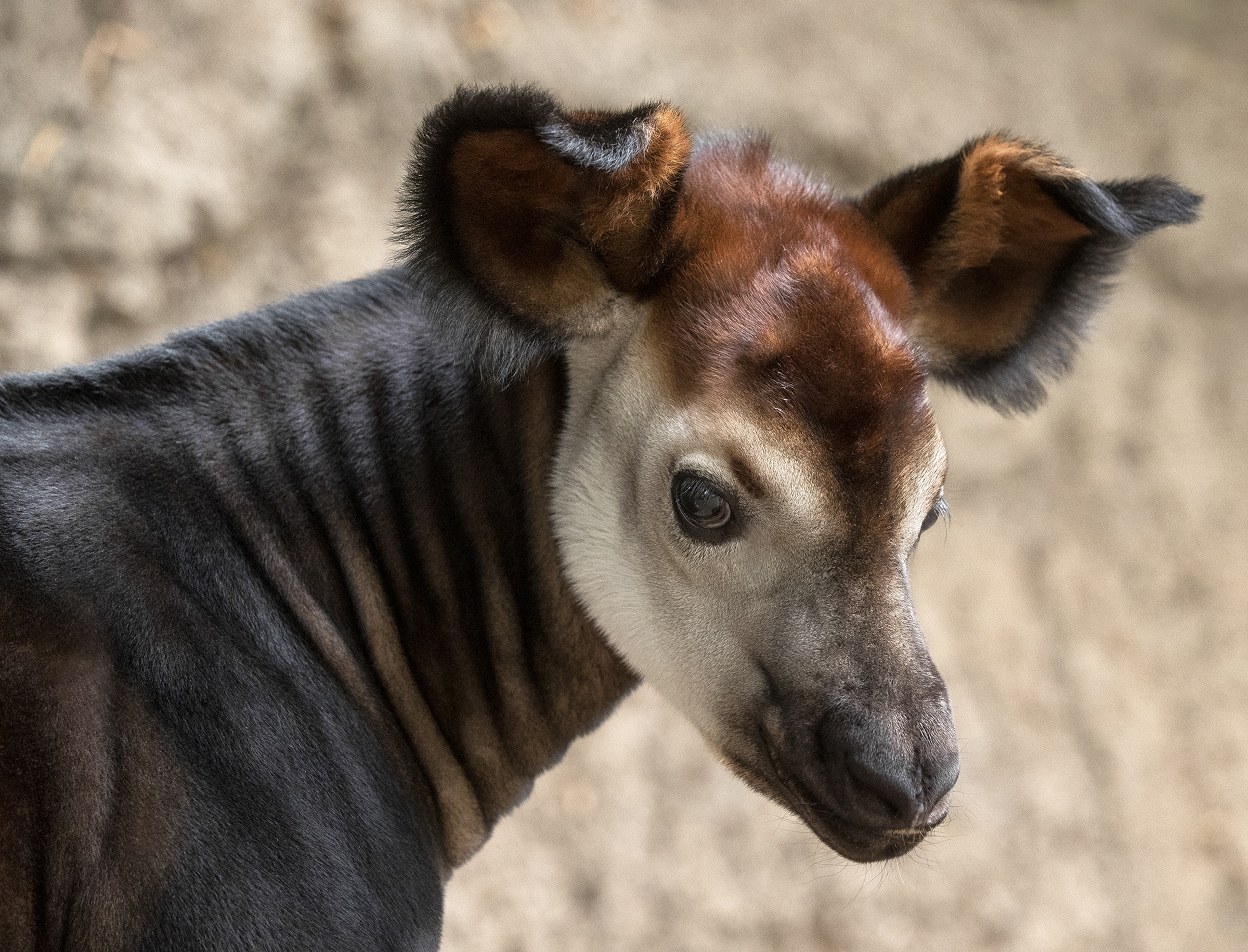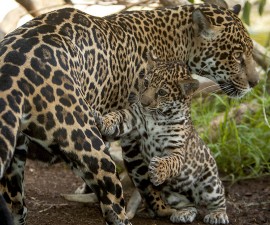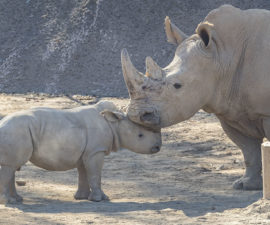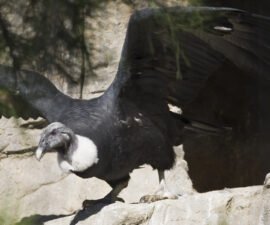BY Karyl Carmignani
Photography by Ken Bohn
You’d have a better chance of being struck by lightning three times on a Thursday than spotting an okapi in its dense, damp, dark habitat in the Ituri Forest, located in northwest Democratic Republic of Congo. Despite being about the size of a thoroughbred horse, this shy, solitary ungulate evaded Western scientific discovery for so long, it came to be regarded as the “African unicorn.” In 1901, Sir Harry Johnston laid claim to its discovery, based on a pelt and two skulls provided by local Mbuti pygmy people, and the species was named Okapia johnstoni to honor him. While the okapi’s striped coat pattern on its rump and legs is reminiscent of the zebra, it is actually related to another iconic hoofed species: the giraffe. They share physical features like an elongated neck, a long, dark tongue, and males growing horns covered in skin, called ossicones—hence the okapi’s nickname, “forest giraffe.” Both are potential prey species, namely of leopards and humans, and remain on ear-twitching “orange alert” to stay ahead of danger. The Central African rain forest provides excellent cover for the observant okapi, but unfortunately they have been in significant decline since the 1990s due to relentless poaching and habitat destruction. Fortunately, an international consortium of zoos and conservation agencies are collaborating both in situ and ex situ to conserve this cultural symbol of survival and intrigue.

Science and Saving Species
 An okapi can delay the birth of her unborn fetus for weeks if birthing conditions are not favorable: hence the range of gestation period of 14 to 15 months.
An okapi can delay the birth of her unborn fetus for weeks if birthing conditions are not favorable: hence the range of gestation period of 14 to 15 months.
In 2016, two female okapis at the San Diego Zoo, Safarani (“Saffy” for short) and M’Baya, bred with a male named Amare. At 25 years old, Safarani had successfully given birth to 3 calves; a fourth would be a welcome addition. The much younger M’Baya had conceived in the past, but never carried a pregnancy for the necessary 14- to 15-month gestation period. Our Reproductive Sciences team monitors the estrous cycles of all female okapis at the Zoo and the Safari Park, and discovered that M’Baya’s progesterone (a hormone necessary to maintain pregnancy) had been erratic in the past, so she was put on a hormonal supplement for this pregnancy. Scientists have found that most pregnancy losses in okapis occur at about the five-month mark. To clear this hurdle, our animal care team turned to a hormone treatment devised to help cheetah, southern white rhino, and greater one-horned rhino mothers maintain “at risk” pregnancies. This was the first time the hormonal supplement had been given to an okapi.
Throughout the lengthy gestation, keepers collected fecal samples three times a week, and sent them to San Diego Zoo Global’s lab for processing, explained Rachel Felton, M.S., research coordinator, Reproductive Sciences. The samples were freeze dried, crushed, sifted, and boiled to separate hormones from the fecal slurry. “Luckily for me, okapis mainly eat leaves, so their poo is less pungent than feces we process from carnivorous species!” Once processed, a radioimmunoassay is used to determine the hormone levels in the fecal sample. “As M’Baya’s pregnancy progressed past the five-month mark, the next question was how long to keep her on the hormonal supplement,” said Rachel. It was decided to slowly wean her off the supplement close to, but before, her due date. She was off the supplement a month before she gave birth on July 21, 2017 to a healthy, 40-pound male calf.
Since 1962, there have been 72 okapi calves born at the Zoo and the Safari Park, largely due to dedicated keepers with a keen understanding of okapi behavior, our unparalleled veterinary expertise, and diligent reproductive hormone monitoring by our lab staff. Unfortunately, Safarani’s calf did not survive, but M’Baya has been a calm, confident mother to her youngster, and she has passed along her easygoing demeanor to him.
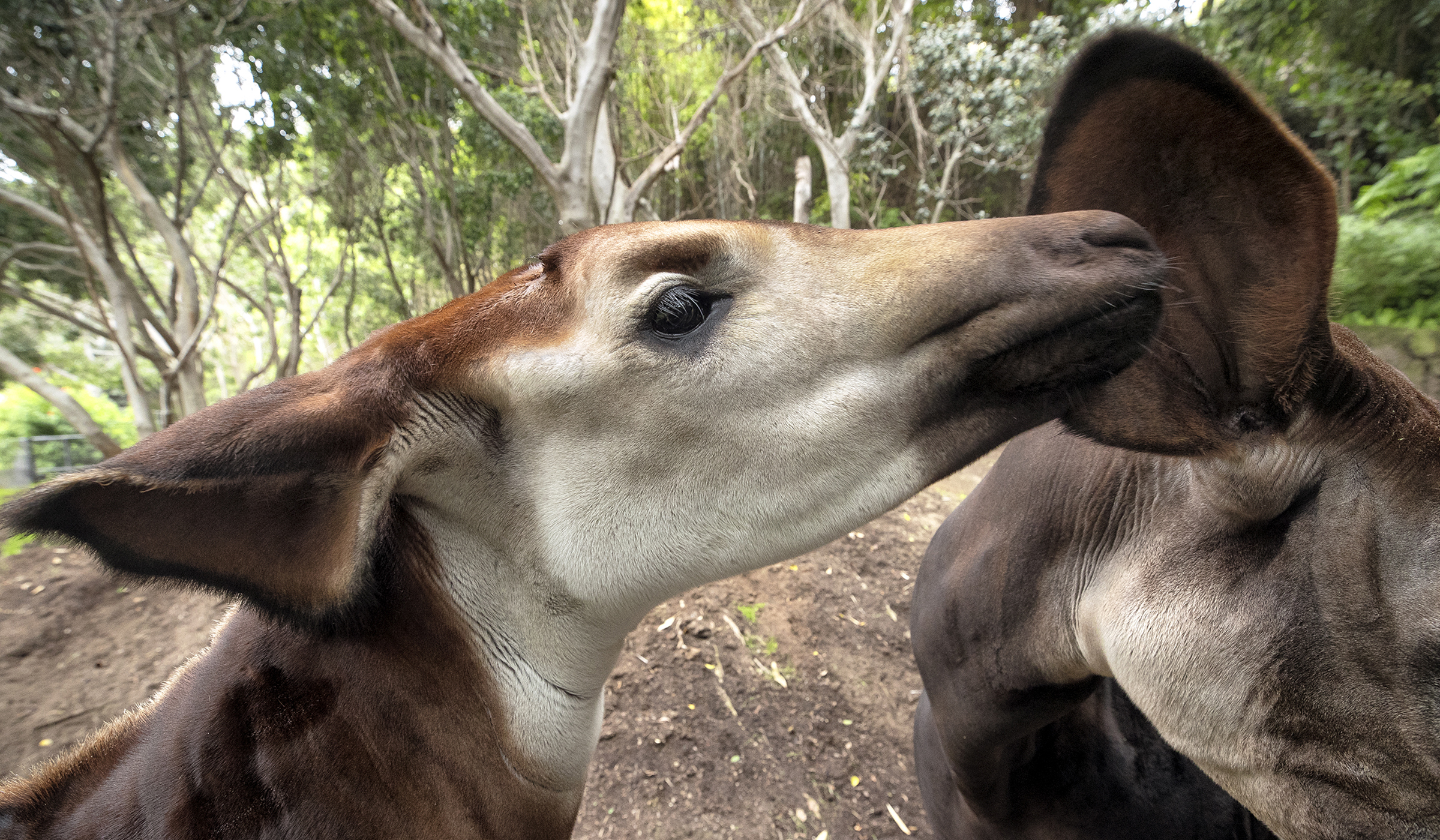
“Mosi” Along
M’Baya’s gangly, floppy-eared calf was named Mosi, meaning “first born” in Swahili. Keepers were excited to work with M’Baya’s calf, but as a first-time mom, “there were a lot of unknowns,” said Jen Chapman, senior keeper at the Zoo. Strict protocols were in place for the comfort of mother and calf and for safety—okapis are the largest animals that keepers have free contact with, meaning there is no barrier between animal and person. Within the first 24 hours, keepers and veterinarians assembled to quickly and efficiently “process” the calf. The youngster called out once, but was reunited with his mom within 10 minutes, and neither appeared stressed. “Later in the day, we separated them again, briefly,” said Jen, “to reinforce that it is okay to be out of sight of each other and nothing bad will happen.” M’Baya trusts her keepers—and Mosi picked up on the vibe.
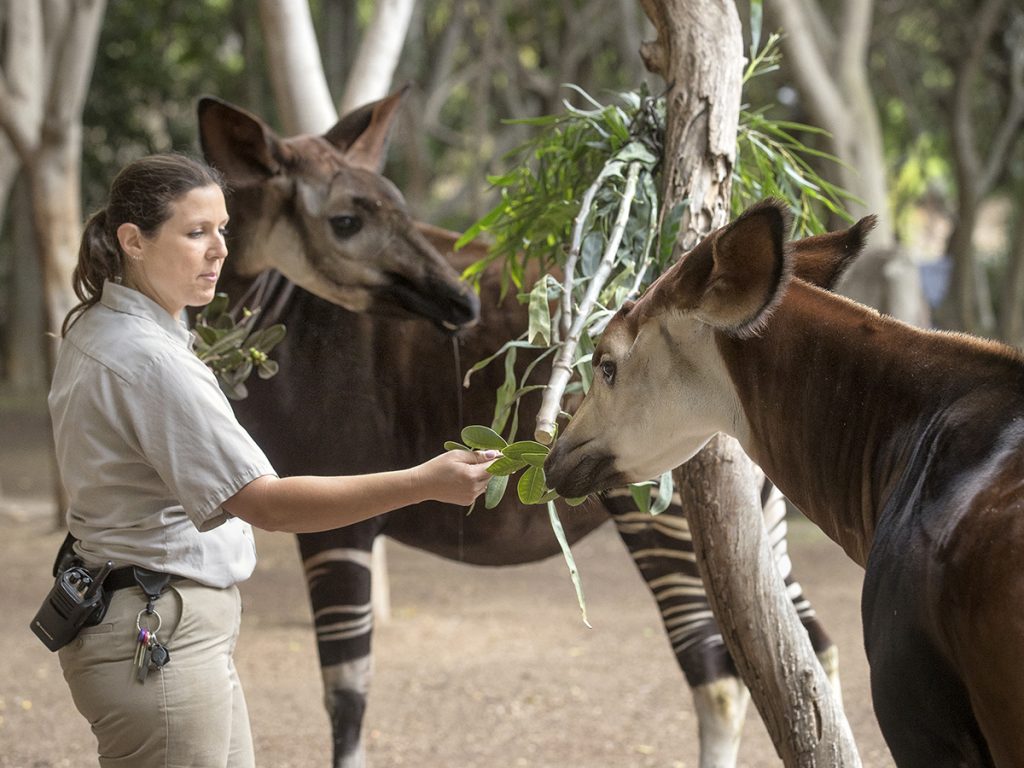
JUST BROWSING
Okapi keepers work with the animals to form trust, which helps keep them calm during health exams and treatments.
Building trust with a prey species whose instinct is to pull away takes time and patience. Jen said that keepers touch M’Baya and Mosi daily to ensure the animals are desensitized to human contact and having their feet picked up, which is important to monitoring their health. In their native habitat, a mother okapi would hide her calf in the forest while she goes to forage, so keepers left M’Baya with browse while they worked with Mosi for a few minutes. “We do tactile work with them twice a day, using their natural behaviors to make being separated stress-free for them.” This early training proved invaluable when Mosi was nine weeks old and twisted ligaments in one of his rear feet. He had to be sedated and taken to the vet hospital to get the foot stabilized in a splint. Not wanting his mom to inadvertently groom it off of him, staff wrapped the splint in duct tape. M’Baya left it alone (thankfully), and five days later, a veterinarian was able to remove the entire bandage with scissors—while Mosi stood still as a keeper soothed him, and M’Baya looked on. “It could have been a negative experience for him,” said Jen, “but having a great, well-adjusted mom really helped a lot. It’s a testament to M’Baya and her easygoing personality.” And also the patience and commitment of the keepers.
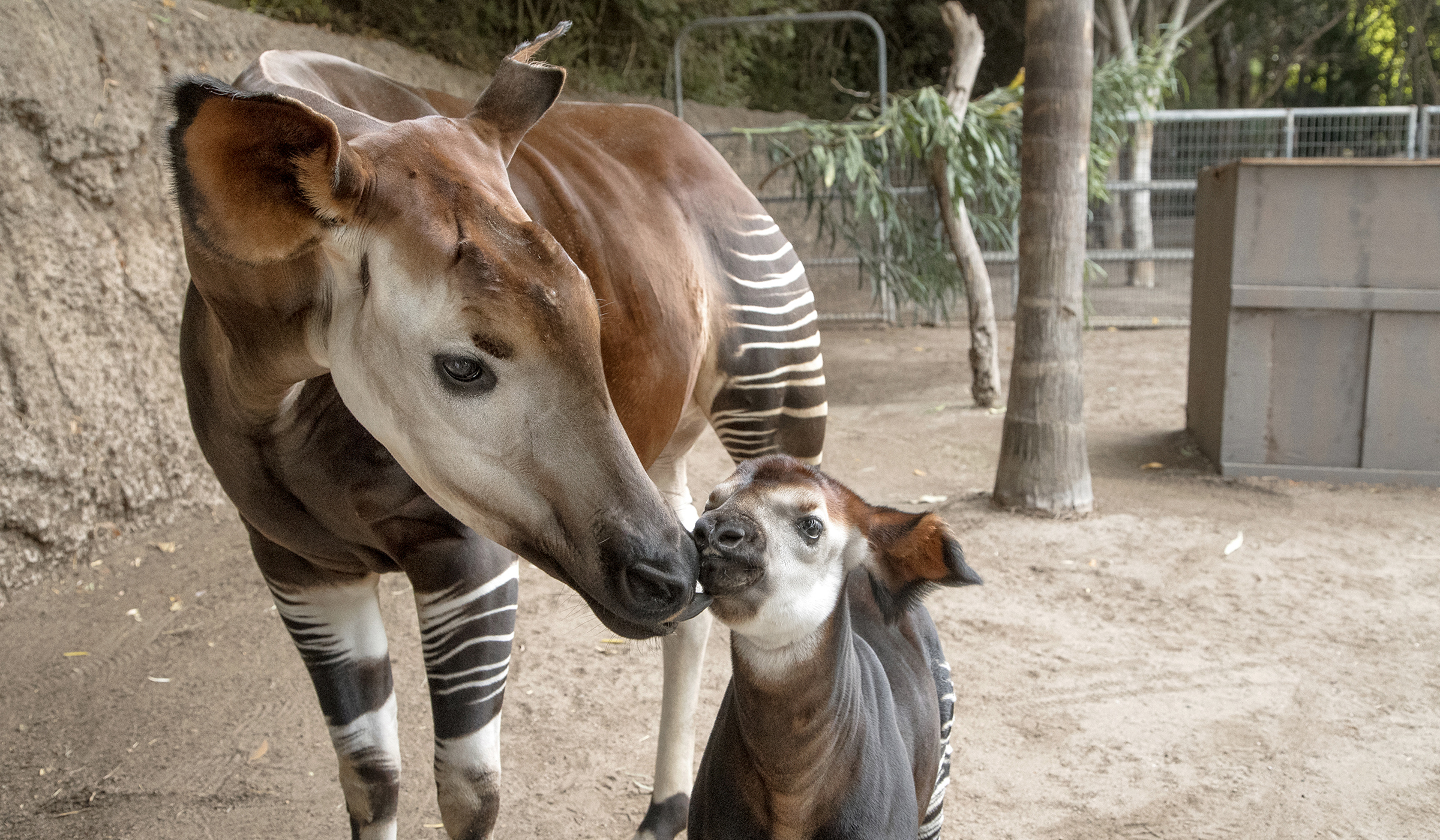
Copy That
The okapi is an endangered species, and San Diego Zoo Global (SDZG) is part of the Association of Zoos and Aquariums’ Okapi Species Survival Plan. We exchange animals with other AZA-accredited breeding institutions to maintain genetic diversity in the North American population. SDZG also contributes to conservation efforts in the okapi’s native forest habitat by supporting the Reserve de Faune a Okapis in the Ituri Forest of the Democratic Republic of Congo. This reserve occupies about one-fifth of the Ituri Forest and is home to about 5,000 of the estimated 30,000 remaining okapi. Luckily, you can see okapis any day of the week at the San Diego Zoo and the Safari Park.

